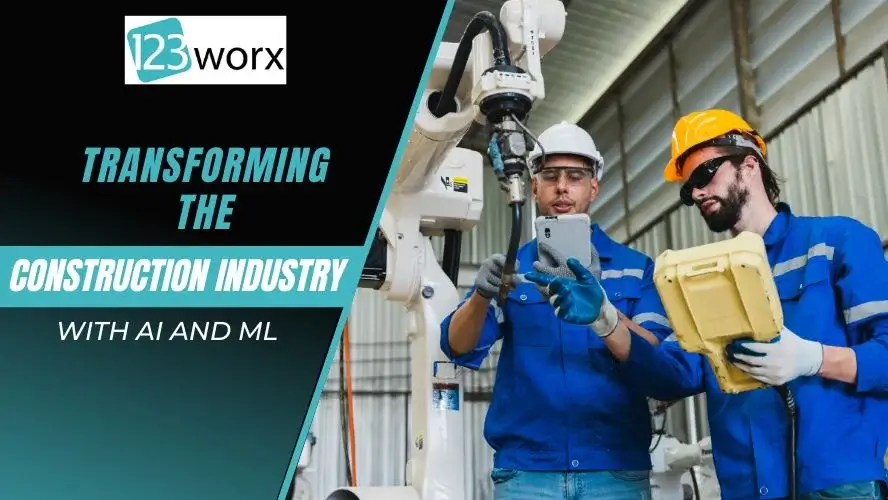As the implementation of new technologies like Artificial Intelligence (AI) and Machine Learning (ML) seeping into its foundation, the construction industry is changing. These advanced techniques are changing how people think about a construction project in ways that bring about optimization, efficiency, and innovation.
In this blog, we’ll explore how Artificial Intelligence has changed the construction industry. You will also read about the many updates, benefits, and practical applications of these technologies. But keep in mind that there may be issues that need attention or even correction for these changes to fully emerge.
Understanding The Impact of AI And Machine Learning in Construction
AI and ML are rapidly changing construction into a more innovative, data-driven decision-making space. These technologies create the potential for savings, streamlined operations, project management, resource optimization, and improved safety measures on the construction site.
By incorporating the power of AI/ML into operations, construction companies can be empowered to do the following:
- Analyze big data to find patterns or insights.
- Carry out repetitive tasks, reducing user errors and increasing efficiency.
- Predict risks and challenges, which will, in turn, enable the organization to implement proactive mitigation strategies.
- Optimize scheduling and resource allocation to improve project timeline and cost management.
The applications of AI and ML in construction are massive; they are involved not only in design, planning, execution, or maintenance but also in project management.
Advancements in AI and Machine Learning For Construction Projects
The enormous advancements that AI and ML technologies have brought to the construction industry can be located in major areas, among which are:
- BIM: AI and ML in BIM aim to automate processes that sense emerging clashes, create optimal designs, and facilitate collaboration among project stakeholders.
- Predictive Maintenance: As with all the other diagnostic buildings, AI and ML algorithms come into play. They sense and predict the point of equipment and infrastructure component failure, reducing downtime and extending asset life.
- Construction Site Monitoring: Computer vision and AI-powered drone solutions can supervise construction sites in real-time. The aim is to ensure protocols are followed, keep track of progress, and raise red flags on any issues at an early stage.
- Material Optimization: ML algorithms can optimize material property analysis and construction methods with environmental conditions to reduce waste and avoid maximum cost.
- Risk Assessment: AI and ML can identify potential risks using historical data and project-specific variables. They provide mitigation strategies and enable informed decisions in project phases.
Benefits of implementing AI and Machine Learning in Construction
The integration of AI and ML in the construction industry offers numerous benefits, including:
- Increased Efficiency: Automating routine operations and optimizing processes may lead to further efficiency and savings in project timelines and costs.
- Enhanced safety: Monitoring systems based on AI with predictive analytics can be used to identify hazards and thereby minimize the risks to human-friendly working environments.
- Improved Quality: AI and ML algorithms can analyze design plans, material properties, and chosen building methods that can meet set standards and building codes.
- Data-Driven Decision-Making: Construction professionals might suggest using data analysis and rough models to make smart decisions based on facts. This can improve project results.
- Sustainability: AI and ML can optimize resource use, reduce wastage, and minimize environmental impacts in construction projects.
Challenges and limitations of AI and Machine Learning in the construction industry
Despite several benefits AI and ML provide to the construction industry, some challenges and limitations also exist.
- Data Quality and Availability: AI and ML models require quality and a healthy amount of data for accurate predictions. Incomplete or defective data will give flawed results, leading to suboptimal conclusions.
- Integrability and Interoperability: Any integration with the existing construction management systems with AI and ML solutions processes would most likely be very challenging, given that the construction industry is highly fragmented.
- Workforce Upskilling: Effective adoption of AI and ML would require a skilled workforce that can understand and use these technologies to derive proper value from them. Therefore, programs focused on training and upskilling will be considered an essential activity in bridging the knowledge gap.
- Ethical and Privacy Concerns: The most ethical and privacy concerns about deploying AI and ML in construction raise data privacy, algorithmic bias, and possible job replacement.
- Regulatory Compliance: AI and ML are continuously evolving, so their regulatory frameworks have to align with them to ensure their responsible and ethical use in the construction sector.
Integrating AI and Machine Learning into Construction Project Management
Using AI and ML will help leverage the full potential of construction project management. This involves:
- Data Centralization: A centralized data repository can be set up to pull, sort, and combine data from any source. This could be from various BIM models, sensor details, or project documents. All of this gets put into a normal dataset that anybody can find and look up.
- AI and ML platform selection: Based on their corresponding needs and requirements, evaluate and choose appropriate AI and ML platforms and tools that are most likely to deliver the desired results for application to construction projects.
- Process Integration: The integration of AI and ML solutions with pre-existing project management processes for a harmonious working relationship and data flow between stakeholders.
- Change Management: Effectively implement AI and ML technologies through change management, which will consider possible resistance and guarantee a smooth transition.
- Continuous monitoring and improvement: Regularly monitoring AI performance and working on its enhancement is crucial. This regular check on AI and ML solutions, along with getting feedback from shareholders, aids in fine-tuning and improving the implementation.
Training And Upskilling The Workforce For AI And Machine Learning Adoption in Construction
The successful adoption of AI and ML by the construction industry is a process that massively relies on it. Hence, companies in the construction sector should be prepared for upgrading and transformation with an equipped and knowledgeable workforce.
- Educational Programs: Work with academic and professional institutions to set up niche-focused training programs on the applications of AI and ML in Construction.
- On-the-Job Training: Conduct practical training and workshops for your current staff to become acquainted with the tools and AI ML processes.
- Cross-discipline Collaboration: Collaboration between construction professionals, data scientists, and AI/ML experts to increase the pool of extensive shared knowledge in an interdisciplinary manner that will solve problems.
- Culture of Continuous Learning and Development: Develop a culture of continuous learning and development within the organization to maintain employee motivation over time regarding AI and ML in construction.
- Talent Acquisition: The office has started hiring and attracting talent with AI, ML, and Data Analytics expertise to supplement the existing workforce.
Future Trends And Predictions For AI And ML in The Construction Industry
With further AI and ML technologies development, the construction industry may be close to more disruptive change.
Some of the future trends and predictions for this technology are:
- AR/VR (Augmented Reality/Virtual Reality): Combining artificial intelligence and machine learning with AR/VR technologies will create a revolutionary way to see project sites. This means users can dive into and engage with planning, training and collaborating.
- Generative Design: AI-powered generative tools will unleash the exploration of innumerable design alternatives. These tools can find the best-fit solution for a range of needs and goals, making design more efficient and durable for our buildings and surroundings.
- Robotics and Automation: AI and ML drive advanced technologies for robotics and automation, which are autonomous operations in equipment, material handling, and monitoring engineering on sites.
- Digital Twins: Digital twins can revolutionize them as digital twins of physical facilities, with added AI and ML potential for far brighter functions of predictive maintenance simulation and optimization.
Accept The Revolution in Construction Industry
The construction sector is rightfully on the brink of a technological revolution with this development—artificial intelligence and machine learning. These advanced technologies can help building firms achieve remarkable standards in productivity, safety, and green practices while keeping them ahead in the dynamic market.
However, effectively using AI and ML needs a smart plan. There’s a need to tackle issues like data quality, linking systems, training workers, and thinking about ethics. By taking on these issues and encouraging constant learning and change, the construction industry can fully use AI and ML. This can help shape a future where smart, data-based decisions are the standard.

As a Vice President at 123worx, Construction Management Platform, Bharat Rudra has worked with hundreds of business executives searching for best-suited software for their construction business with a wide array of requirements. Bharat takes pride in helping construction businesses solve their business and project management challenges. Feel free to reach Bharat if you have any questions. You can find him on LinkedIn or reach him at brudra@123worx.com

